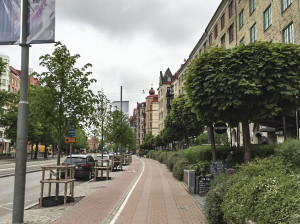A city’s vegetation can affect its air quality both positively and negatively. The positive effect is that the total amount of air pollution decreases because the air is being filtered. On the other hand, vegetation in crowded street canyons can degrade the air locally if deployed in such a way that the plants shut in the air pollution.
“The possible negative effect is because the plants act as a windbreak and reduce the wind speed, which decreases the dilution of local emissions and may increase their levels nearby. It is consequently important to think about where the vegetation is placed”, says Swedish National Road and Transport Research Institute (VTI) researcher Sara Janhäll.
This is a major risk in dense urban environments, where the dilution of air pollutants may be limited even without vegetation. It is consequently important, for example, to avoid planting trees densely in constricted and heavily trafficked street canyons.
“On the other hand, vegetation can be deployed as a barrier between emissions sources and people, for example, along major transport routes, so that the dissemination of the pollutants is limited and the air is filtered as it flows along”, says Janhäll.
VTI Report 876 describes the current state of the research in this field, and offers recommendations for planting urban vegetation. Here are some of the recommendations, which are clarified in greater detail in the report:
- It is preferable to place vegetation near the emissions source where the levels are high, so as to increase the possibility of filtering out pollutants or diverting the polluted air.
- Use vegetation advantageously as barriers between the traffic and people. Choose low hedges if it is important to dilute the pollutants at the location.
- Right from the start, plan what types of vegetation are to be planted and where, taking into account all of the effects of vegetation that may arise in a complicated urban environment. Weigh different elements of the environmental effects against one another as well.
- “At present it is difficult to describe plants in a way that directly captures their effect on air quality. Further research in this field is of major importance and is ongoing, which means that both the physical designs [of road infrastructure] and the vegetation choices are constantly evolving”, says Janhäll.
Report:
VTI report 876, The effect of vegetation on air quality.
Authors: Sara Janhäll
Link to report (in Swedish, with English summary)
 Contact: Contact:Sara Janhäll, Researcher sara.janhall@vti.se VTI, Sweden |







Follow us: